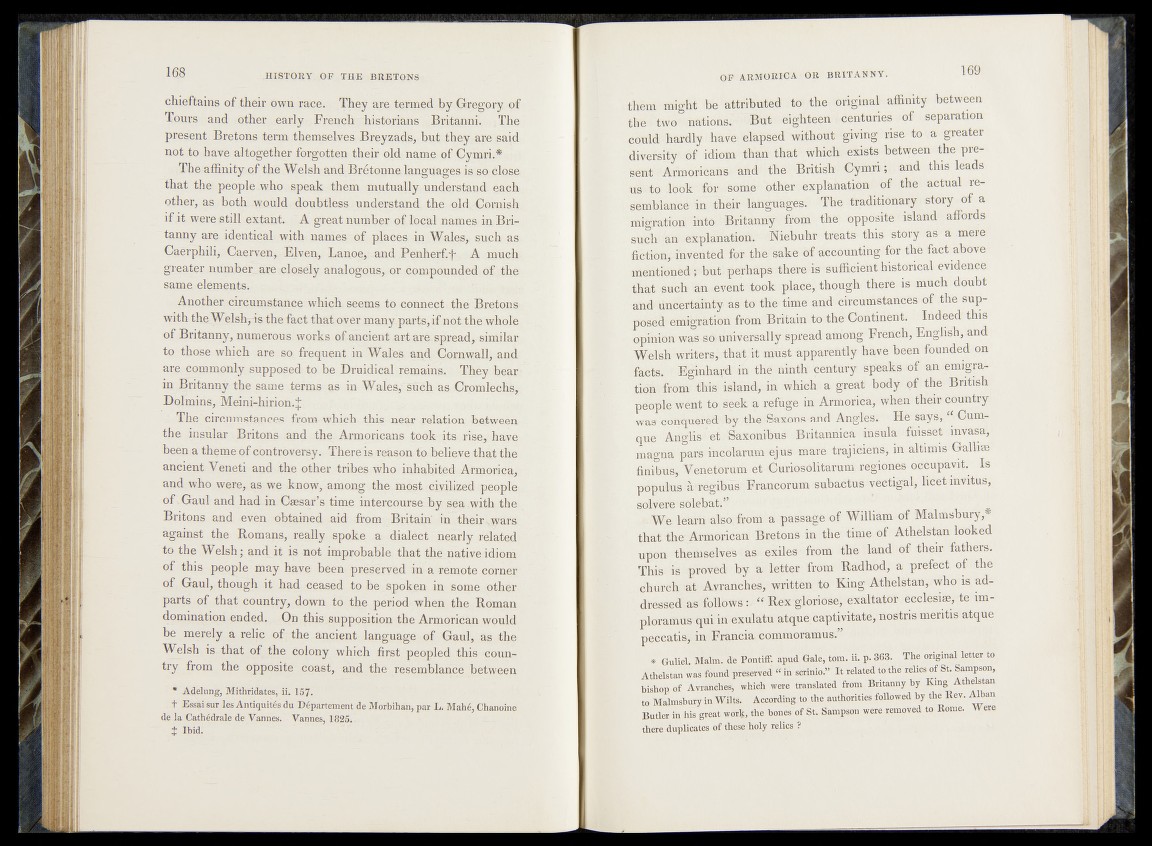
chieftains of their own race. . They are termed by Gregory of
Tours and other early .French ~historians Britanni. .The
present. Bretons term themselves, Breyzads, but they?are said
not to have, altogether forgotten their old-namCi of Cymri.*
The affinity of the Welsh and Brétonne.languages is;,so; close
that theipeople-who . speak them mutually, understand, each
other, as.both would-doubtless understand the old,-Cornish
if it were still extant.. A great number of local names- in Bri-
tanny are identical with- names of .places in Wales* such/sis;
Caètphili, Caerven, Elven, Lànoe, and .Penhfr^=| A ngith
greater number.are closely analogous,:or compounded!of the
same elements. .
Another, circumstance which, seems to connect* the Bretons
with thc Welshjts the fact that over manyiparts,if npt the whple
of Britanny, numerous works of ancient .art arers^read, similar
to those which are-so frequent in Wales apd Cornwall^and
are. commonly supposed to be Druidical remains. They bear.-
in Britanny the same terms-- as in Wales,' such as Cromlech^*
Bplmihs, Meini^hirion.J
’ The circumstances from which this near relation between
the. insular Britons and the Armoricans took- it&.Efe@^hasy%
beena theme of controversy. There is reason CpJ^Me^e.that the
ancient Veneti and the other tribes.who inhabited Aimoriedb
and who were, as we know, among the most civi];izedc4|^oplei
of. Gaul andhacLin. Caesar’s time intercourse ,by sea .n ith^thos.
Britons and even obtained aid from Britain' in their ^ a r s
against the Romans, really spoke a dialect nearly related
to the Welsh ; and it is not improbable that the native idiom
of this people may have been preserved in a remote corner
of Gaulr though it had ceased to be spoken in sorçe other
parts of that country, down to the period when the Roman
domination ended. Qn this supposition the Armorican would
be merely a relic of ; the ancient language of Gaul, as the
Welsh is. that of the colony which first peopled this coun-
try from the opposite coast, and the resemblance between
* Adelung, Mithridates, ii. 157-
t Essai sur les Antiquités du département de Morbihan^ par L. Mafaé, Chanoine
de la Cathédrale de Vannes. Vannes, 1825..
t Ibid.
them might he attributed to the original affinity between
tbe v two' - nations^ But eighteen t centuries • of \ separation
could hardly haivte-elapsed without giving rise to a greater
diversity - of idiom than that which exists between the present
Armoricans and the British Cymri; and this leads
us*t<$>4bbk for-some 'other explanation* of - the actual re-
somblanc&in their/-latfguagesf'1 The traditionary story of a
migrate# into 1 Britanny- "iom); the* opposite? island affords
s%eh' an' .explanation.1 Niebuhr treats- this story as a .mere
fiction;-invented for the sake -accounting for the fact above
ldenti'oped | but': peihaps'TtheTehs’ »su-fficient historical evidence
that such» a n ie n t Itook place* though there as* much doubt
and uncertainty as to the time andvcircumStances of .the sup-
p“Osblrtemfgf ailOn from Britain to'#tb Continent. Indeed» this
opiJi^fewas>sO> univcpsalfy'^spread afrfong French, ^English, .and
Welsh writers,'\lSbd$t must apparently have been founded on
faCteftf Eginhard in f he-ninth centuryifepeaks of an emigraj--
tionifroln this»;island, in whiohks great body of the British
people W&|to\seek a refdge-in Armorica, when them country
was' dOo4uered4by ’th#&W»and He Cumjque
^Affgp^el/Saxorftfeus - Britannic a insula ffuisset mvasap
magh# trajibierfs^ in' altimis'Gallise
fiMlhuS^'Peii’etbram et -©tiriisblitarum, regioneS oifcupavit.- Is
popukts -ai^gibus 'Francorum*subactus wbctig&l, licet invitus,
solvefe’SOlcbat,5'’ '
. vWb. learn alspfrom a-passage of William OfMalmsbury,*
that the Armorican Bretons in the-time of Athelstan looked
upon themselves - as. exiles«* from the land of their- fathers.
This is proved by a letter from Rad hod;-a prefect of the
_ church iat Ayranches,1 written to King Athelstan,-who'is ad-
' diessed as.follows :. “ Rex gloriOse;-.exaltator>ecclesi8c/-te im-
ploramus quiin.exulatu atquocaptivitate, nostns meritis atque
peccatis, in Francia. commoramus.”
* (Juliet. Malm, de Pontiff, apud Gale, tom. ii. p. 363. The original letter to
Athelstan was found preserved 1 1 scrinio.” i t related to the'relie^of St. Sampson,
bishop, of Avranches, which were translated from Britanny by Kmg Athektan
to Maimshury in Wilts. According to .the authorities followed by the Kev. Alban
Butler in ««great wort, the bones'of St. Sampson were removed to Rome. W ere
there duplicates of these holy relics ?